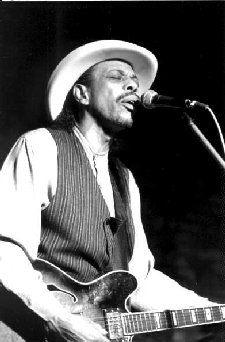 John Primer is one of the driving forces in helping to keep alive the more traditional Chicago blues sound. Born in 1945 in Camden Mississippi John was raised on share-cropper land. "I went to school in the morning," he said, "and worked in the fields in the afternoon and night." After moving to Chicago in the early 60’s one of the first things John did was put together a band. By the end of that decade he landed a gig playing lead guitar with the house band at Theresa's where he backed up the likes of Junior Wells, Louis Myers, Jimmy Johnson, Lonnie Brooks, Paul Butterfield, Johnny Winter, Bonnie Raitt and many others. From there he joined Willie Dixon's band, The Chicago Blues All Stars in 1979. Six months later he was asked to join Muddy Water's band after being referred by Mojo Buford. This turned out to be Muddy's last band (with Lovie Lee on piano) and it was a shock to Primer when Muddy died. Primer said, "Muddy was a great guy and I was ready to play with him as long as he wanted me to." After that great experience he played for the next 13 years with Magic Slim & The Teardrops saying he really enjoyed all those years, "We were like a family, like brothers." Finally, in 1996 with the encouragement of Maurice Holt, John set out on his own with his own band and his new solo album.
John Primer is one of the driving forces in helping to keep alive the more traditional Chicago blues sound. Born in 1945 in Camden Mississippi John was raised on share-cropper land. "I went to school in the morning," he said, "and worked in the fields in the afternoon and night." After moving to Chicago in the early 60’s one of the first things John did was put together a band. By the end of that decade he landed a gig playing lead guitar with the house band at Theresa's where he backed up the likes of Junior Wells, Louis Myers, Jimmy Johnson, Lonnie Brooks, Paul Butterfield, Johnny Winter, Bonnie Raitt and many others. From there he joined Willie Dixon's band, The Chicago Blues All Stars in 1979. Six months later he was asked to join Muddy Water's band after being referred by Mojo Buford. This turned out to be Muddy's last band (with Lovie Lee on piano) and it was a shock to Primer when Muddy died. Primer said, "Muddy was a great guy and I was ready to play with him as long as he wanted me to." After that great experience he played for the next 13 years with Magic Slim & The Teardrops saying he really enjoyed all those years, "We were like a family, like brothers." Finally, in 1996 with the encouragement of Maurice Holt, John set out on his own with his own band and his new solo album.
The following is an interview with John that took place in April, 2000.
Ray: What was it like growing up in Mississippi, was it a hard life?
John: It was a poor, hard life. I shared a bed with 4 other kids. The whole family lived in one house. 10 adults and 7 children. Everyone worked in the fields to put dinner on the table. I was born in this family home.
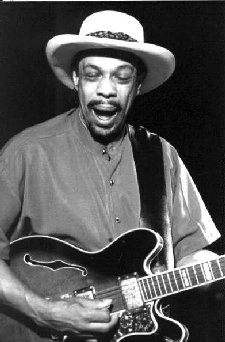
Ray: When did you start listening to music and what kinds of music?
John: I was 2 or 3 years old when I first remember music. I listened to my grandmothers radio. I heard Blues, Gospel, Country & Western and R & B.
Ray: What did you like to listen to?
John: I liked the Blues the best.
Ray: What got you interested in becoming a musician?
John: When I was young a friend of mine had a guitar that I played with. My uncle put a guitar on the side of the house for me. He used a wire with 2 nails.
Ray: How old were you when you started to play guitar and how did you learn the instrument?
John: I was 9 years old when I first started to play guitar. Family members and friends showed me the basics.
Ray: I understand you moved to Chicago in 1963? Why did you make the move there?
John: I moved to Chicago with my mom and stepfather to get a good job in a factory near my house on the West-Side of Chicago.
Ray: Did you know anyone in Chicago when you moved there?
John: My mother, stepfather, cousins and friends of the family were already living in Chicago before I got here.
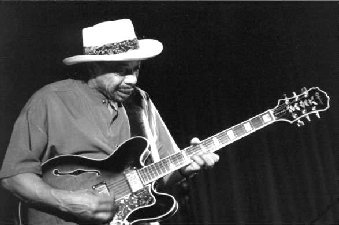
Ray: What was the music scene like when you got there? Who did you get to see, meet, play with, etc.?
John: I played with a band called the Maintainers. We played Rhythm & Blues and Soul music (top 40). This was very popular back then. I met Mr. Milton and he got our band together. Arthur Adams (rhythm guitar), Robert Gregory or "Poncho" (bass) and James Ford (drums). I got to see Little Milton, B.B. King, John Lee Hooker, Howlin' Wolf, Magic Sam, Jr. Wells and Buddy Guy all at the Regal Theater on the South-Side of Chicago.
Ray: Was Maxwell Street still active then and did you play there?
John: Maxwell Street was a very active and thriving place. I played there every Sunday from 8 a.m. till 3 p.m. with Pat Rushing.
Ray: What was it like on Maxwell Street?
John: Back then Maxwell Street was the place to go. Music everywhere, food cookin, flea markets selling everything you can imagine. People came from all over the world to eat, shop and to especially hear the Chicago Blues.
Ray: Any interesting stories you can tell me from that time?
John: While playing lots of people would dance and sometimes they would get into fights over women, money or whiskey. They would kick up so much dust we would have to stop playing. It was funny to watch. No one got hurt bad, just trouble makers.
Ray: Who were some of the other young musicians your age that you met, played with, became friends with?
John: Michael Coleman, John Little John, Willie Kent, Luther Allison, Dave Myers, Louis Myers, Bob Myers, Sammy Lawhorn, Lucky Peterson and Buster Benton.
Ray: Tell me about your first bands and playing in the clubs during this time. What did you do to play around town?
John: I was in the Maintainers Band back then. The clubs were packed with both whites and blacks. The crowd was really into the music and they got really wild. I played a lot of jam nights to get my name out there.
Ray: Who were the major influences on your guitar playing and music in general (vocals, showmanship, writing, playing, etc.)?
John: Muddy Waters, Jimmy Reed, Howlin' Wolf, Elmore James, Lightin' Hopkins, B.B. King, John Lee Hooker and Magic Sam.
Ray: How did you get the job at Theresa's in 1974?
John: I met Sam Goode playing with the Transistors Band and I went to their rehearsal. He told me that a club called Payton Place needed a guitar player. I sat in and jammed a few songs with them. On the break John Watkins (the band leader) asked me to join the band. I said yes. I met up with them at Theresa's Lounge to rehearse on a Sunday night. That night Theresa threw a beer can at John Watkins and told him "don't play that shit in my bar." John Watkins was playing a rock song. He got upset and stopped the rehearsal. He told me that he was sick of this and gave me the job at Theresa's Lounge. I played there as the house band for 8 Years.
Ray: How was that experience important to you in your career?
John: Theresa's Lounge was very important. Playing 7 nights a week lots of people got to see me play. I met a lot of very influential people in the Blues world. People like: Johnny Winter, Paul Butterfield, Jr. Wells, Buddy Guy, Pine-Top Perkins, Mojo Buford, Otis Rush and many more.
Ray: You joined Willie Dixon in 1979? What was that experience like? What did you learn from Willie?
John: Playing with Willie Dixon was another huge opportunity for me. Willie did a lot for me when I was starting out. He got my passport and took me to Mexico City. This was the first time I had ever been out of the United States before. I learned how to play many of the old traditional songs from him. I also learned how important it is to write my own music.
Ray: Do you have any good Willie Dixon stories you can share?
John: While in Mexico City when we were getting ready for the show, Willie dressed us all up in big sombrero's. We wore these huge hats all night. It was hilarious and the people loved it. He also wrote a Mexican song that we performed on stage. Willie was always having fun and cracking lots of jokes all the time.
Ray: When did you first meet Mojo Buford? How about Muddy Waters?
John: I met Mojo Buford in 1980 and Muddy Waters in 1979 in Mexico City while I was playing with Willie Dixon. He heard me play and asked Willie about me.
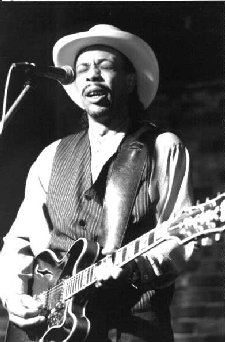
Ray: When did you start playing in Muddy's band? How did that come about?
John: I started playing for Muddy on July 11, 1980. I was working at Theresa's Lounge and Muddy's band came to see me play. Mojo Buford told me that Muddy wanted me to play as his guitar player and that I need to see him about it. That was how it happened.
Ray: What was if like playing with Muddy?
John: It was a dream come true. I fulfilled a huge goal of mine. I was in shock that this was happening to me. Playing with Muddy was like playing with a king.
Ray: Can you describe your experience with Muddy?
John: I learned how to play like him. I learned about the music business from him. Muddy taught me to respect other musicians. He took care of me and the band like a father to his sons.
Ray: Do you have any good stories about Muddy you can share with me?
John: Muddy was always cracking jokes and having fun. He took very good care of us in the band. When we were in Toronto Canada we played a concert and people started jumping the fence so we had to stop playing and run back to the dressing rooms. Muddy beat all of us back to the rooms. He could run really fast and was in good shape for his age. He kept to himself a lot. He was a true professional and a true Blues Man. I loved him very much.
Ray: What did you learn about music and playing from him?
John: I learned how to play that deep down & dirty Blues that people loved. He told me to never change my style for anyone. He also taught me how to play the slide guitar.
Ray: After Muddy died in 1983 you hooked up with Magic Slim a year later, how did that happen?
John: I was playing at Theresa's Lounge again and Nate Applewhite (Magic Slim's drummer) came by to tell me that Magic Slim needed a guitar player. Later Nick Holt (Magic Slim's brother and bass player) asked me to join the band.
Ray: What was it like playing with the Holt brothers for the next 13 years?
John: It was the time of my life. We were a family. I learned how to be a leader from Slim. Magic Slim also gave me a lot of room to grow and improve my guitar style and my vocals. Our styles were so different that he encouraged me to play my style.
Ray: I remember the first time I saw you, it was at the Blues Saloon in St. Paul a number of years ago with Magic Slim (I think it was in March because I remember it was around my birthday and yours too). You started playing your guitar with your remote on up in the balcony and then made your way down those dangerous stairs and on up to the stage. That was a memorable experience.
Ray: What did you learn from your time with Maurice and Nick Holt?
John: I learned not to ever be afraid to play the Blues, always play from my heart and stay in control.
Ray: When did you leave Slim to go on your own? And why the move at that time?
John: I left Magic Slim in 1995 because it was time. It was over due for me to be independent and go out on my own. I got signed to Atlantic Records and I had a lot of good people around me supporting my decision.
Ray: Tell me about George Baze
John: George Baze was a very close friend to me. We were like brothers and we told people we were brothers. I have known George for 25 years. We were always together and played a lot together. He played in my band with me for a couple years before he died. He was a very special person and a huge influence on the Blues. He is greatly missed by all of us.
Ray: Who plays with you now when you tour? Wasn’t Steve Bell with you on harp a while ago?
John: Steve Bell - Harmonica, Brian "Bo" Trisko - 2nd guitar, Michael Morrison - bass and Mark Diffenderfer - drums. Steve Bell (son of harp legend, Carey Bell) has been in my band now for 4 years. I have known Steve and his family since Steve was a little kid.
Ray: What are the albums you have released as a solo artist?
John: The albums I have done solo are:
Poor Man Blues - Wolf Records
Stuff you Gotta Watch - Earwig Records
Blues Behind Closed Doors - Wolf Records
Cold Blooded Blues Man - Wolf Records
The Real Deal - Atlantic\Code Blue Records
Keep on Lovin The Blues - Atlantic\Code Blue Records
The Zoo Bar Collection Vol.6 - Wolf Records
It's a Blues Life - Wolf Records...NEW RELEASE IN APRIL
Knockin At Your Door - Telarc Records...NEW RELEASE IN MAY
Ray: What other albums have you played on?
John: I have produced and recorded with the following artists:
Magic Slim, Johnny B. Moore, Nick Holt, Eddy Shaw, Lurrie Bell, Vance Shaw, John Brim, Michael Coleman, A.C. Reed, Hubert Sumlin, Little Mack Simmons, Melvina Allen, Willie Kent, James Cotton, Jimmy Rogers, Detroit Jr., Big Daddy Kinsey, Big Smokey Smothers, Billy Branch, Johnny Johnson, Bonnie Lee, Pinetop Perkins, Mojo Buford, Muddy Waters, Honeyboy Edwards, L.V. Banks, Vance Kelly, Phil Guy, Johnny Law, and many more…
Ray: Your new album is on Telarc, how did your association with that label come about?
John: The main influence was through a long time friend and my producer Mike Vernon. With his brains and reputation the sale was easy.
Ray: Tell me about that recording session? Didn't Larry McCray play on the album with you?
John: I had a lot of fun working and playing with Larry McCray, Steve McCray, Mathew Skoller and Al Brown. We spent six 12 hour days in the studio. We had good times, but worked very hard. Mike Vernon helped inspire me and push me to a new limit. He is a true professional. I tried a new style on this album. Singing "Excited By Your Charm," I tried to echo the same tones, feelings and sounds of the original. A much more gritty sound. Also a mono-tone and slower blues sound. Very different from how I normally sing. Guitar Center in Chicago supplied me with lots of toys...I mean guitars to choose from. I chose 5 different Gibson guitars for the CD. 2 Gibson Acoustics, 1 Les Paul and 1 Hollow Body Epiphone guitar. I wrote 7 songs for this CD. I had all of these songs written in about 5 days specifically for this CD.
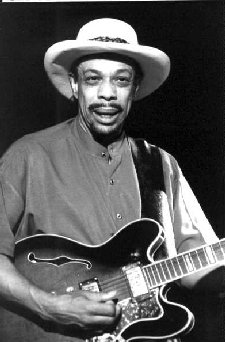
Ray: Tell me about Larry's guitar style compared to yours.
John: Larry plays differently than me. He plays the Blues like Freddie King. His rhythm guitar reminds me of spirituals. His solos are hard driving and fast. The Fender Guitar sound is a mix of Blues, Rhythm & Blues and Gospel. He is amazing!
Ray: Who do you like to listen to today (live or on record)?
John: I like to listen to Muddy Waters, John Lee Hooker, Jimmy Reed, Bobby Bland, Howlin’ Wolf, Albert King, B.B. King, Elmore James, and myself.
I love all blues, these are my favorites. As far as a live performance I like to see Buddy Guy, Little Milton and Johnny Winter play live.
Ray: What do you think of some of the new, young blues players coming up today?
John: They are the future of the Blues. It makes me feel good to see them carry the Blues into the future. There are many different styles out there. I like the traditional styles better. The old time Blues. Ronnie Baker Brooks and Lucky Peterson are a couple of my favorites. I make a point of showing my support to all the young talent.
Ray: How would you describe your style of blues and your guitar style?
John: My style of the Blues is the original style. I try to keep my style close to the original form. I also play the slide. I keep the strings tuned to A 440 and I finger pick in-between the slide notes. No one else plays the slide like me. I learned this from Sammy Lawhorn and Muddy Waters. When I play I feel a deep down, good feeling in my heart and I try to share that with the audience.
Ray: How did you learn to play slide?
John: I learned to play slide from watching Sammy Lawhorn and Muddy Waters. Sammy gave me lots of help, one on one. I tuned the guitar to one key in A 440 when I first started off. Hearing Elmore James play slide in D inspired me greatly. Today I still play like Sammy did, but when I am recording I use Elmore's style (The Real Deal album).
Ray: Where do you go from here, what are your plans?
John: I have a special talent. I use this talent to touch many people. My goal is for now to continue to play what is in my heart to make people happy. Hopefully I will become a success in the process. My future plans are to have my own studio and to be able to help the hundreds of musicians with talent. I want to give them a chance to make it and at the same time give back what I have been given. I also see myself doing this instead of being on the highway. I want to teach people the traditional Blues to make sure it stays alive. These are goals I hope to reach in the next 5 years.
Ray: Did I miss anything that you would like to talk about or comment on?
John: Nope.
That last response seems to sum up John Primer, he really is a man of few words who prefers to let his music do the speaking for him!
This review is copyright © 2000 by Ray Stiles, and Blues On Stage, all rights reserved. Copy, duplication or download prohibited without written permission. For permission to use this review please send an E-mail to Ray Stiles.
